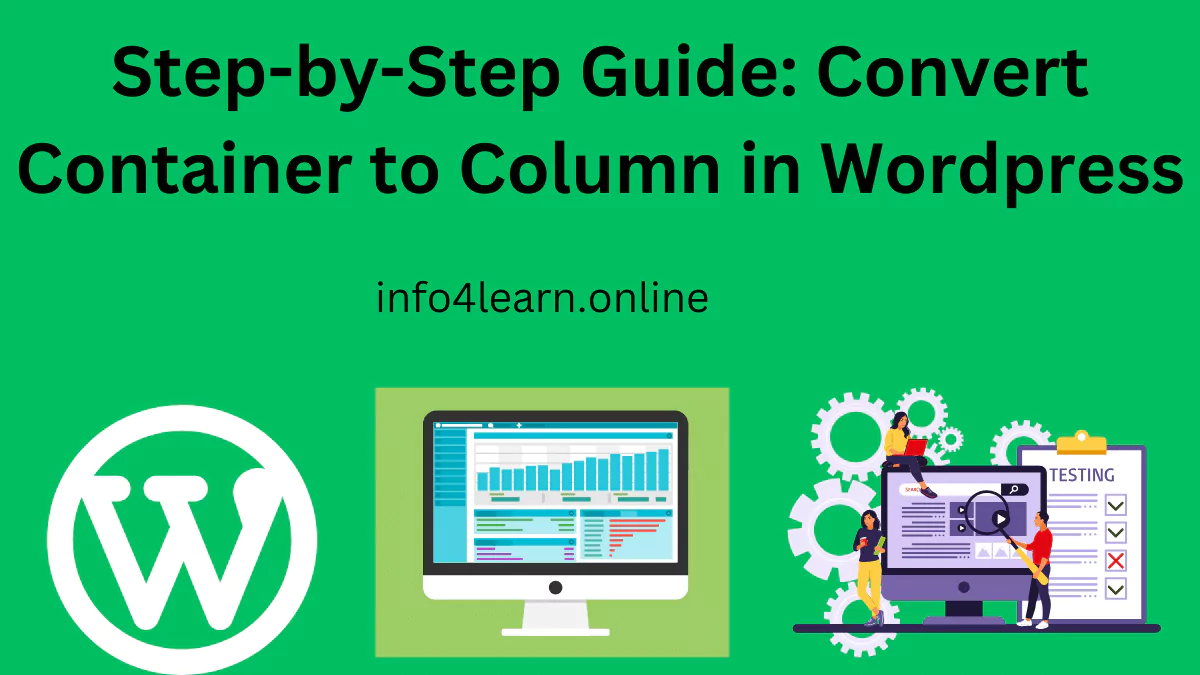Finding How to Convert Container to Column in WordPress [Updated 2023]. You are on right place. We explore How to Convert Container to Column
Introduction
In the dynamic world of web design, mastering the art of customization is crucial. WordPress, a leading content management system, offers many options, but sometimes, the default layout must align with your vision. One common challenge is Convert Container to Column in WordPress, requiring a blend of technical skills and creative thinking.
Table of Contents
Understanding WordPress Layout
Before diving into the conversion process, let’s grasp the basics of WordPress layout. WordPress structures content within containers, defining the overall design. While this default setup caters to many, there are situations where a more dynamic approach is needed.
What is a Container in WordPress?
Containers act as the building blocks of a WordPress page, holding content like text, images, and widgets. They provide structure but can sometimes limit the flexibility needed for unique designs.
Importance of Columns in Web Design
Columns are the backbone of modern web design. They organize content, enhance readability, and create a visually appealing layout. Understanding their significance is crucial in unlocking the full potential of your WordPress site.
Challenges with Default WordPress Layouts
Default WordPress layouts might not always align with your aesthetic or functional preferences. This can be restrictive, especially when envisioning a design that stands out. Fortunately, converting a container to a column can offer the flexibility needed.
Must Read: How to Convert Your WordPress Website to a Flutter App 2024?
Benefits of Converting Container to Column
Conversion is not a random choice. There are definite benefits, such as increased design adaptability, greater user experience, and the capacity to better present multimedia material.
Step-by-Step Guide: Convert Container to Column
Step 1: Identifying the Target Container
Determine the precise container you want to transform before starting the conversion process. This guarantees accuracy and avoids unexpected changes.
Step 2: Choosing the Right Column Structure
Choose a column structure that goes well with your material after evaluating it. WordPress offers a number of column choices that let you customize the layout to your needs.
Step 3: Adding Custom Styles
Consider adding custom styles for a completely distinctive appearance. To do this, modify the CSS according to your preferred design style. Ensure responsiveness and compatibility for a seamless user experience.
Step 4: Testing Responsiveness
Always check the responsiveness of your freshly created layout. A gorgeous desktop design ought to transition flawlessly to mobile platforms.
Step 5: Common Mistakes to Avoid
It’s simple to make mistakes when customizing something, which is exciting. Avoid making your design too complicated, skipping responsiveness, or adding too many plugins that can make your site load slowly.
Step 6: Optimizing for SEO
The importance of SEO cannot be overstated. Make sure your SEO efforts are not jeopardized by your new look. Keep your code clean, use suitable header structures, and optimize your images for quick loading.
Step 7: Responsive Design and User Experience
The user experience is crucial. Your site will be accessible on all platforms thanks to a responsive design, which will appeal to a wide range of users.
Step 8: Exploring Advanced Techniques
Explore advanced approaches for individuals looking for more than the fundamentals. For a fully interactive experience, this can entail incorporating animations, conditional logic, or dynamic content loading.
Step 9: Tools and Plugins for Easy Conversion
Make the task easier by utilizing plugins and tools made for customizing layouts. Even people without substantial coding experience can benefit from these in streamlining the conversion process.
Step 10: Case Study: Successful Conversion Stories
Study examples from the real world. Examine case studies of companies or bloggers who successfully transformed containers to columns to achieve their intended visual appeal and usefulness.
Step 10: Troubleshooting: What to Do If Something Goes Wrong
Only a few conversions are successful. Learn about typical issues and troubleshooting techniques to be prepared for eventual challenges. This guarantees a speedy recovery in the event of a mishap.
Conclusion
WordPress users can now easily construct one-of-a-kind, aesthetically pleasing layouts in the constantly changing world of web design thanks to the option to transform a container to a column. By embracing personalization, you improve the appearance and usability of your website.
FAQs
Can I convert any container on my WordPress site?
The target container must be identified, and you must make sure the conversion fits with your overall design plan.
Do I need coding skills for this conversion?
Basic knowledge of coding is helpful, however for individuals with less technical knowledge, user-friendly plugins are available.
Will converting affect my site’s SEO?
If done properly, the effect on SEO ought to be negligible. But make sure the right optimization techniques are used.
What plugins do you recommend for easy conversion?
Elementor, Beaver Builder, and Divi are well-liked plugins that provide simple user interfaces for layout adjustment.
How often should I test for responsiveness after conversion?
Regular testing guarantees that your website is responsive on a variety of devices, particularly after upgrades.


1 thought on “Best Way To Convert Container to Column in WordPress [Updated 2023]”